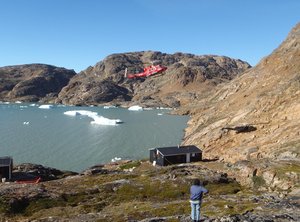Sermilik Research Station

Address
Department of Geosciences and Natural Resource ManagementGeocenter Denmark
University of Copenhagen
DK 1350 Copenhagen K
Denmark
Station manager
Aart KroonContact Station
Phone: (+45) 35 32 25 00https://ign.ku.dk/english/about/field-stations/sermilik-station/
Station Features
Opening year: 1970 Status: OpenFacilities
Station name and owner
The Sermilik Research Station is owned by the Department of Geography and Geology, Geocenter Denmark, University of Copenhagen.
Location
The station is located at 65°40’ N and 38°10’ W in southeast Greenland, about 20 km north of the small town Tasiilaq (Ammassalik). The station is situated on the shore of the Sermilik Fjord on the west side of Ammassalik Island adjacent to the Mittivakkat Glacier, a local small ice cap.
Climate data
Grey colours are WMO Climate Normals including maximum and minimum values. Blue colours are individual years.
Climate data for the stations where extracted via Copernicus Climate Data Store, from the global gridded reanalysis product:
ERA5 monthly averaged data on single levels from 1940 to present.
Description and source code: Roemer J.K. 2023. https://doi.org/10.5281/zenodo.10214922
Data Source: Hersbach et al. 2023. Copernicus Climate Change Service (C3S) Climate Data Store (CDS), https://doi.org/10.24381/cds.f17050d7
Biodiversity and natural environment
The research area is situated in the low arctic coastal vegetation zone, and demonstrates a large flora diversity. It is dominated by dwarf-shrub heaths, snow-bed communities, and open fell-field communities. Fens, herb slopes, and copses are present but are only found in smaller niches in the alpine dominated landscape.
History and facilities
During an expedition in 1933, led by the famous polar researcher Knud Rasmussen, the first surveys of glaciers and geomorphology were carried out on Ammassalik Island and at the Mittivakkat Glacier. In 1970 a permanent field station, the Sermilik Research Station, was established, to provide a logistic base for the ongoing glaciological, hydrological, and geomorphological investigations of the Mittivakkat Glacier and its catchment. In 1993, an automatic meteorological station was established at a nunatak situated close to the equilibrium line of the Mittivakkat Glacier to study the glacier climate (515 m a.s.l.). In 1997, a second meteorological station was established, to study the climate in the coastal region. A third meterological station was established at about 200 m a.s.l. in 2009, comprising data on short wave incoming radiation, temperature, relative humidity, wind (direction and speed), and precipitation. The main building of the station is an insulated wooden house of 60 m2 with three rooms for scientists, a dining room, a living room, a kitchen, a toilet, and a storage room. A second, non-insulated building of 50 m2 holds workshop, equipment, generator, a rubber boat, as well as optional accommodation for four persons in a separate room. The station buildings allow for accommodation of 6-10 researchers. During student summer field courses a tent camp is established at the station.
General research and databases
The station supports a comprehensive year-round monitoring programme covering basic climatology and local climate gradients in the Mittivakkat Glacier drainage basin, glacier mass balance, run-off and sediment transport, and the development of coastal and delta geomorphology. Data are available on request from the three climate stations and a hydrometric station. Glacier mass-balance measurements and glacier surveys has been carried out since the mid 1980s and delta surveys since 1989. Maps, digital 3D terrain models, satellite data, and aerial photographs, in addition to a complete bibliography of publications arising from research at the Sermilik Research Station are available on request.
Station Monitoring
Human dimension
More than half of the population of East Greenland (c. 3000 inhabitants) live in the town Tasiilaq (c. 1700 inhabitants) which is located 20 km south of the research station. Even though the traditional Inuit culture still plays a major role in daily life, Tasiilaq is also a modern community. Fishing, hunting, service industries, and tourism are the major businesses in the town. The Ammassalik Island and the valleys behind the town have a unique flora and are popular places for hiking.
Access
The Sermilik Research Station can be reached by commercial air carrier via Island to Kulusuk Airport (Greenland Air or charter flights) followed by a helicopter flight to Tasiilaq. From Tasiilaq to the station a boat or a helicopter charter is recommended depending on the weather, snow, or ice conditions, and the amount of luggage/cargo. It is also possible to reach the station after a 15-20 km hike. It is highly recommended to book favourable air tickets half a year in advance and to plan at least two travel days to reach Sermilik Station from Europe.


